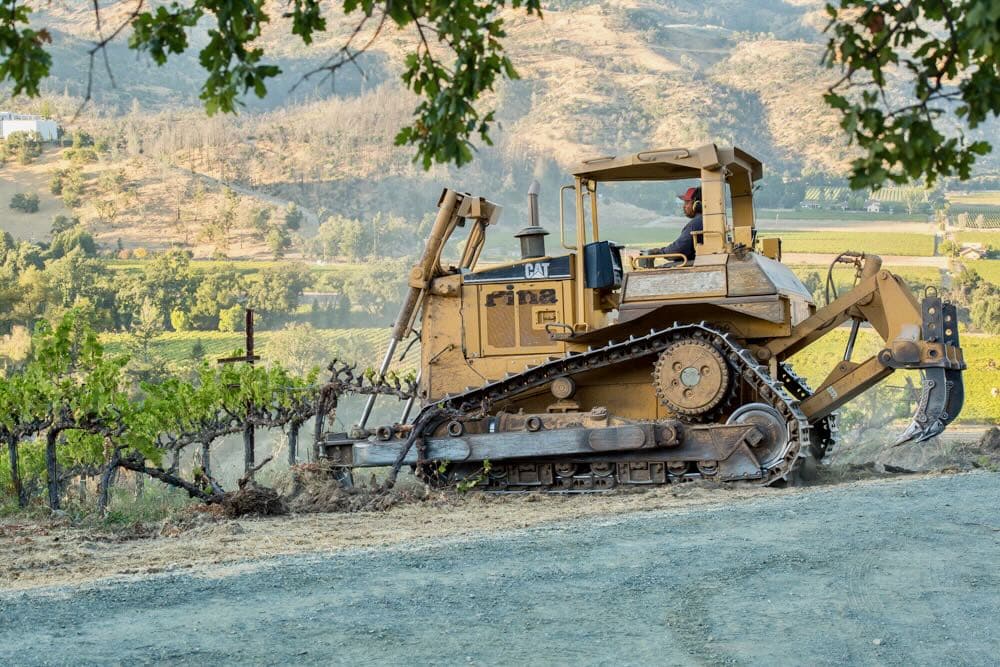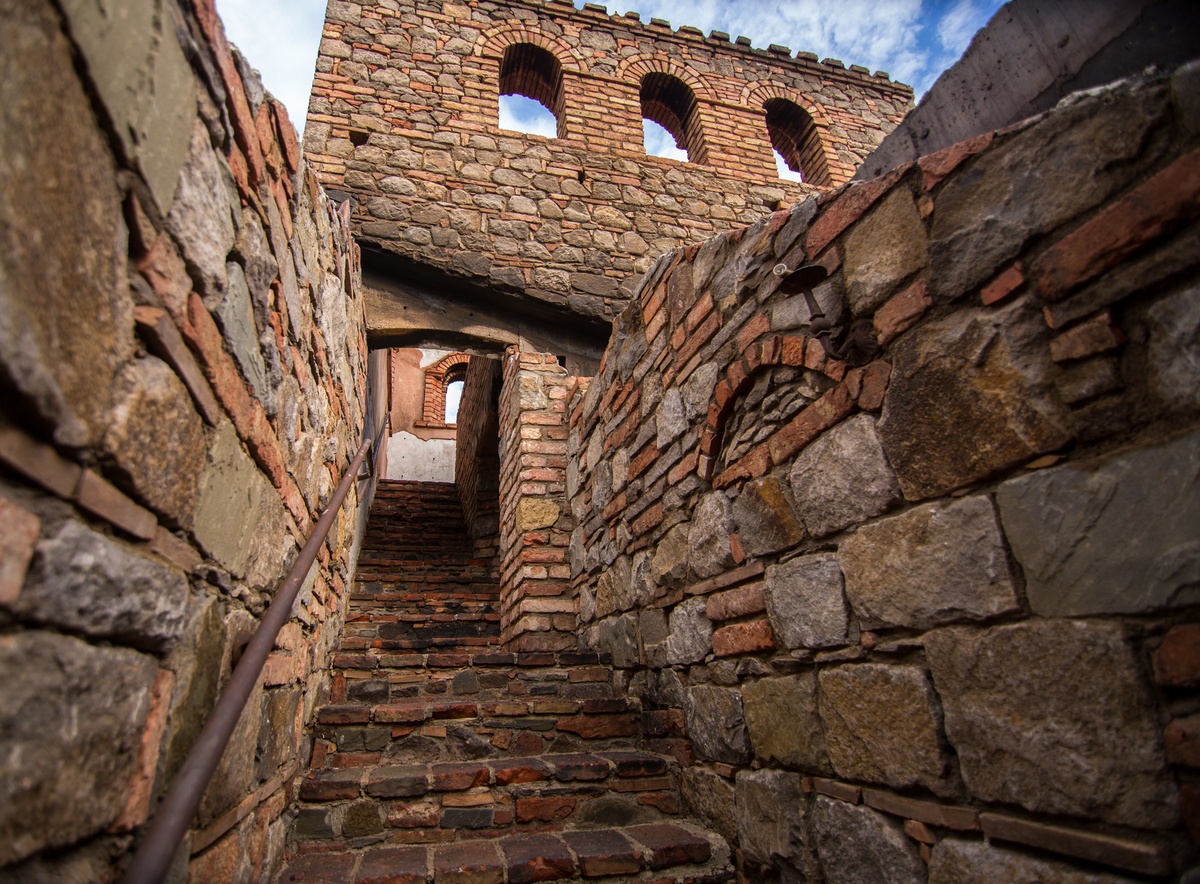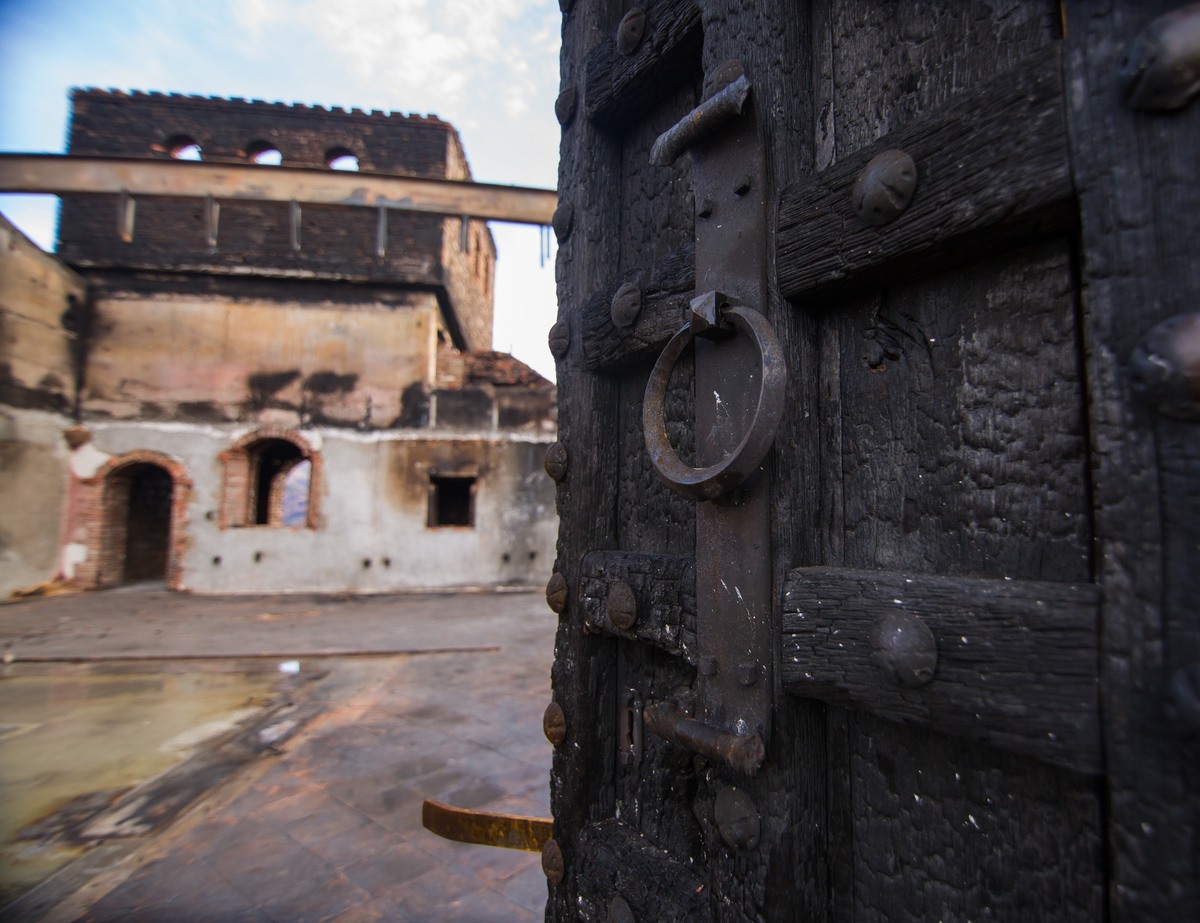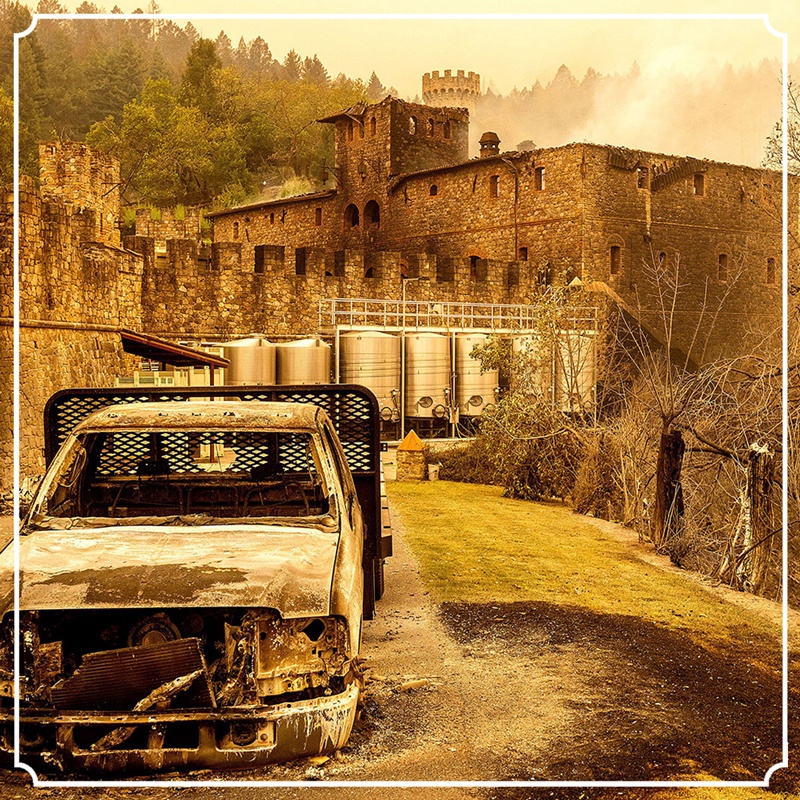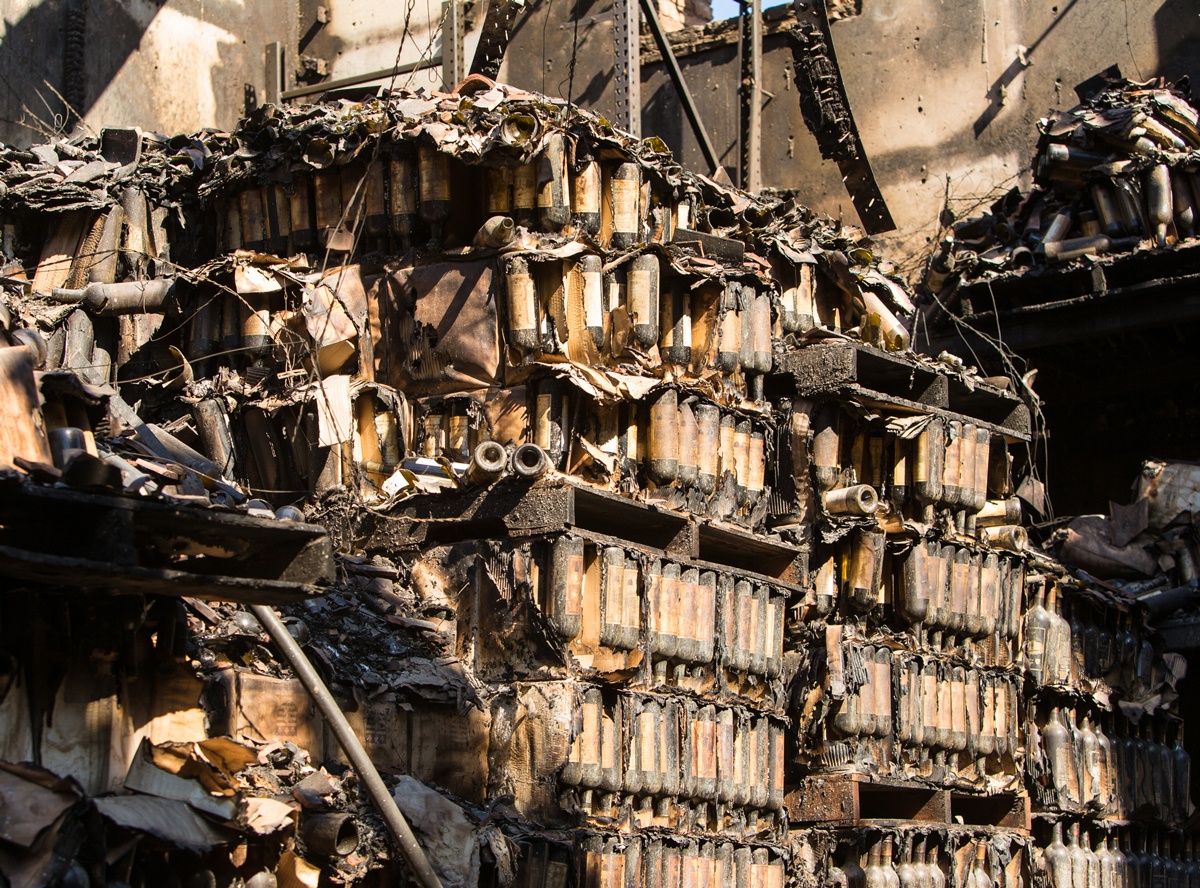Operation Vine Removal and Replanting

Operation Vine Removal and Replanting
Castello di Amorosa, nestled in the hills just south of Calistoga in the northern end of Napa Valley, has long been a symbol of tradition, craftsmanship, and excellence. The Castello, built by pioneer winemaker and winery owner, Dario Sattui, has been recognized as an architectural masterpiece that combines centuries-old medieval material with state-of-the-art winemaking equipment.
For over 25 years, lush rows of Cabernet Sauvignon, Merlot, Sangiovese, Malbec, Primitivo and Petit Verdot vines surrounding the Castello have produced some of the region’s most coveted wines.

But change is in the air around the Castello. Starting in late September 2024, the vineyard will undergo a remarkable transformation—its iconic vines, which have given so much over the years, are being removed.

Time is of the essence. Erosion control ordinances require the vines to be removed and the erosion control to be implemented before October 15 and no work can be done until the following April when planting will begin. Vineyard blocks 5, 7 and 10 will be planted in April of 2025. The investment in vine removal and replanting is $1,000,000 for the ten acres of blocks being replanted.




Over time, even the best vines begin to show their age. Though the wines from Castello di Amorosa have remained stellar, the vineyard’s team, led by visionary vintner, Dario Sattui, Castello President, Georg Salzner and Director of Winemaking, Brooks Painter, knew it was time to embrace renewal. “It’s a bittersweet moment as I can vividly recall the first planting of the Castello vineyards,” Sattui said, “but if we want to continue producing the highest quality wines for the next generation, we must replant. The terroir is the same, but the potential for what we can achieve is limitless.”
As we await the perfect moment to harvest, the work in our vineyards never ceases. One of the most important tasks at hand is ensuring our vineyards continue to thrive and produce exceptional fruit for future vintages. While many factors can influence the yield of grapes, the longevity of the vineyard depends heavily on the strategic replanting and care of the vines themselves.
As Dario Sattui explains, “Vines, like everything in nature, have a life cycle. While some vines can live for over 100 years, most of our vines reach their peak around 25 to 30 years. At this stage, their ability to produce optimal fruit diminishes, and that’s when we know it’s time to invest in the future of our vineyard.”
For Castello di Amorosa, this means carefully replanting select blocks of the vineyard, including blocks 5, 7 and 10, with Cabernet Sauvignon in 2025. The decision to replant isn’t made lightly, as it requires patience and foresight. By removing entire blocks, we have the unique opportunity to introduce new, disease-resistant rootstocks and clones of Cabernet Sauvignon that will elevate our winemaking legacy. “Replanting is a chance to secure our future,” Dario adds, “to ensure that Cabernet Sauvignon remains a cornerstone of our vineyards, delivering the quality and character our wines are known for.”
This process is about more than simply pulling out old vines; it’s about maintaining a balance between the vineyard’s current productivity and long-term prosperity. While pulling full blocks means those areas won’t yield grapes for a few years, the investment we’re making today is what will ensure Castello di Amorosa remains at the forefront of Napa Valley winemaking.
Gallery
Click on the images below to see them in high definition

Jim Sullivan
Jim Sullivan, Vice President of Public Relations and Marketing spearheads Castello di Amorosa’s publicity and marketing initiatives.
With over 20 years of marketing, public relations and business development experience with professional motorsports teams and in a variety of healthcare organizations in Southern California, Jim first joined Castello di Amorosa in 2008 as Public Relations and Marketing Manager.
An avid cyclist, Jim fell in love with wine and wineries while exploring the Washington State countryside. His love of wine was reinforced during subsequent trips to the Napa Valley to visit family.
Jim holds an MBA from the University of Redlands and a Bachelor of Science from Central Washington University. He resides in Calistoga, Calif.
Solar at The Castle

Solar at The Castle
We invested $1.4 million in a 450-kilowatt solar power array. The massive 1162 panel system was completed in January of 2022 and is situated on a spot which had been a forested slope but was significantly burned in the Glass Fire that hit the Napa Valley in 2020.
“This enormous investment is an important element of our commitment to become as self-sufficient as possible while minimizing our carbon footprint and helping with the climate change crisis. We expect this will offset our energy usage around 80%,” explains Georg Salzner, President, Castello di Amorosa.

Castello di Amorosa partnered with Centrica, Recolte Energy, 127 Energy and DEIF on the multiple components of this installation. 127 Energy designed the 556-kilowatt battery storage microgrid. Using advanced and remotely accessed power controls, the solar microgrid provides Castello di Amorosa with an independent power supply during frequent utility grid outages. During times of normal operations, the solar microgrid reduces utility energy charges and demand charges, resulting in significant operational savings for the winery.
“Due to fire risks and skyrocketing power prices, commercial business owners in California are taking matters into their own hands. Castello di Amorosa, Centrica Business Solutions, and Sungrow were great partners on this project and our collaboration exemplifies how innovative teams can solve daunting environmental and energy-related challenges,” said Mark Crowdis, CEO of 127 Energy. “The battery storage microgrid provides a striking juxtaposition of resilient, clean energy technology against the backdrop of historic castle grounds,” Crowdis added.

Other examples of Castello di Amorosa’s environmentally friendly programs and practices:
· Napa Green Certified: the winery has been Napa Green Certified since May 2018 (renewed in June 2021). Being Napa Green Certified’s requirements include LED Lighting, using a minimum of 50% recycled paper in the winery offices; using recycled cardboard and recycled pulp for shipping (instead of Styrofoam), using green certified cleaning agents and hand soap; using recyclable/compostable plates/flatware.
Bio Microbics Micro Fiber filtration system: the winery treats all of its processed water (water used during production of wine) and re-uses it for landscaping. Since 2017, the winery has treated and re-used over 5,000,000 gallons of water.
· The winery has begun composting as of January, 2022.
· Napa Ride Share program: the winery pays employees to carpool, thus eliminating more cars on the road.
Castello di Amorosa owns and farms 130 acres in Napa, Sonoma and Anderson Valley.

Glass Fire Part II

Jim Sullivan
Jim Sullivan, Vice President of Public Relations and Marketing spearheads Castello di Amorosa’s publicity and marketing initiatives.
With over 20 years of marketing, public relations and business development experience with professional motorsports teams and in a variety of healthcare organizations in Southern California, Jim first joined Castello di Amorosa in 2008 as Public Relations and Marketing Manager.
An avid cyclist, Jim fell in love with wine and wineries while exploring the Washington State countryside. His love of wine was reinforced during subsequent trips to the Napa Valley to visit family.
Jim holds an MBA from the University of Redlands and a Bachelor of Science from Central Washington University. He resides in Calistoga, Calif.
The Clean Up Is Complete
After 1,800 hours of work, the Farmhouse that was burned in the Napa Valley Glass Fire is clean and ready for rebuilding- a 2-to-3-year process- that will utilize same painstaking process that led to the building of Castello di Amorosa, also know as the Napa Castle
Dario hired Zucco Structural Engineers of Santa Rosa to evaluate the existing 10-inch cement walls that are faced with stone and bricks. Zucco were the engineers that produced the original structural plans for the Farmhouse. We are hopeful that the structural report confirms that the walls were not damaged to the extent that they will need to be razed.
Once we have confirmation, we will need to obtain a permit from Napa County to rebuild. We will need thousands of handmade, antique roof tiles, bricks, doors, and metal work from Italy as well as timbers. Artisans from Europe will need to come to Castello to perform the work, to recreate the Farmhouse exactly as it was before the Glass Fire.
In rebuilding the Farmhouse, Dario will reaffirm the two of the original guiding principles used in the building of the Castello. First, the building will be rebuilt authentically. Second, it will be authentic which means it will take time. The rebuilt Farmhouse will not be a contemporary building that mimicked the medieval style. As he would say, you cannot build an “old structure” using modern techniques and tools and it cannot be fake! So, like the Castle itself, you will see hand-shaped bricks, stone, roof tiles and wood used as the building materials.
Fritz Gruber, a master builder, who furnished most of the bricks from Austria will be called on once again in the Farmhouse rebuilding project.

Much of the stone will be sourced locally and worked by masons familiar with old stonecutting techniques. The roof tiles are hand made by artisans in Europe.
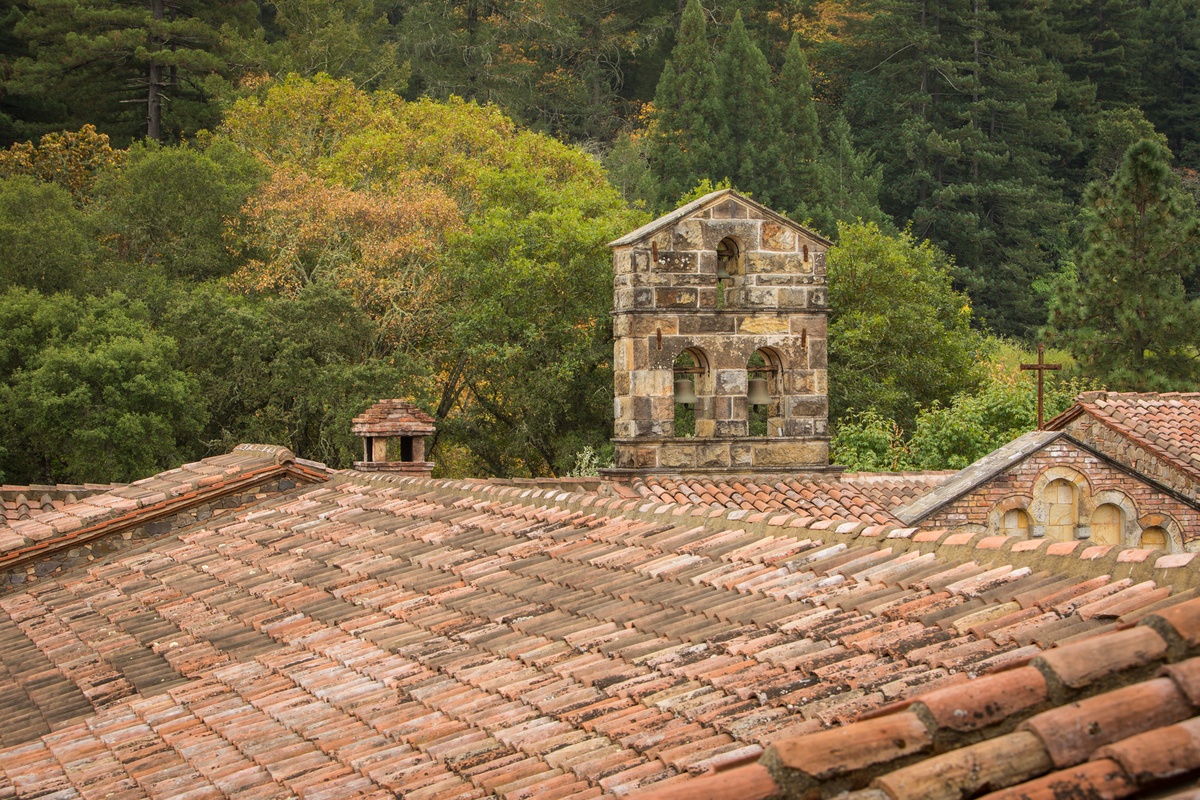
The ironwork including the light fixtures, hinges, locks will all need to be fabricated by Giorgio Mariani, a blacksmith who Dario met in Assisi in 1998, and his son who reside in Umbria, Italy. These talented artisans created the wood doors and window surrounds for the Castle and we will ask for their help, once again, in the Farmhouse project.

It is likely that the former construction manager of the Castle project, Paulo Ardito will return for the Farmhouse Project. It was Paolo who built the Gatehouse, a tractor barn and office/storage building that is left of the main gate in 2014.

Stay tuned to this blog for the next update. If you have not already done so, please sign up for our newsletter (Hyperlink) to stay up to date with all the latest from the Castello.
Glass Fire Part I
Read Part 1 of our Glass Fire Blog, featuring a message from Dario Sattui.

Glass Fire

Dario Sattui

Glass Fire Update
We have received an outpouring of love and support from our community and members, for which we are so grateful. In the midst of this challenging time, the team at Castello di Amorosa wishes to share with you a message of hope, fortitude, and resilience. While it is true that we have been affected by the fires, losing our Farmhouse building and scorched land surrounding the castle, we are grateful that our main castle building which spans 121,000 square feet has been left unscathed. We owe this to the hard work of the police, first responders, and firefighters that have continuously dedicated their efforts to saving our beautiful property. After seeing the flames, Dario’s first instinct was to save all of the animals at the castle, including the pigs, goats, sheep, emus, peacocks and chickens.
Looking to the future, it is time for us to come together as a community and to support one another. Wine country is strong, courageous and resourceful and we will get through this challenging time together and more unified than ever before. The incident has been heart-wrenching and devastating for the Castello di Amorosa Team, but through the tumult, our team and the spirit of Dario’s Labor of Love persisted.
– Castello di Amorosa Team

A Letter from Dario Sattui
Dear Friends & Family,
I spent nearly 15 years of my life designing and building the castle, which besides my wife Irina, is the second love of my life. I never thought the stone and brick fortress would be affected by fire. Unfortunately, in the early morning hours of September 28th, Castello di Amorosa sustained significant fire damage to the Farmhouse building, a separate 15,000 square foot building across the crush pad about 50 yards from the castle itself. The Farmhouse was completely destroyed. The beautiful castle itself and underground cellars which comprise approximately another 121,000 sq. ft. were not harmed by the fire.
Flaming embers landed in the grass near Highway 29 creating a massive fire that ripped up the hill to the Farmhouse before I knew it. My first response was to let our farm animals out of their pens, and then I raced to find a fire truck which responded quickly, but it was just too large a fire to handle. Fortunately, most of our wine inventory is stored in the castle and in our off-site warehouse and is in great condition.

The Farmhouse contained about 120,000 bottles of wine with a retail value of approximately $5 million, a bottling line, a portion of the wine from the 2020 vintage and offices and a laboratory above. The castle itself was unaffected by the fire. I estimate that repairing this craftsman building and re-equipping it will cost approximately $10-12 million and take 2-3 years as most of the antique materials must come from Europe. The estimated total loss is approximately $15-20 million.
I really appreciate your heart-felt support during this difficult time. Your calls, emails and wine orders are very much appreciated. I am thankful for your support of the castle and honored that you continue to purchase and enjoy our wine which will help sustain the castle during this horrible time.

I am thankful that no one was injured and want you to know that we are strong and resilient, and we will overcome this tragedy. Our hearts go out to our friends and neighbors, some of whom have suffered great losses. We are forever grateful for the hard work and dedication of the brave fire fighters and the first responders.
We are already hard at work repairing systems and getting back on our feet.We expect to resume shipping your wine orders by the end of the week and to reopen the castle within a week for wine tasting.
I am looking forward to putting this disaster behind us and hosting you again at the castle soon.
I wish you and your family all the best.


Farmhouse Update
No one ever thought the 2020 Glass fire of September 28 which started on the east side of the Napa Valley near Crystal Springs road would ever make it to the east side of the valley. But the unthinkable quickly became reality at the hands of the fierce, 40 mph winds that fateful evening.

Dario Sattui was worried. He was up at 1:00 a.m. to assess the conditions. He drove to the Napa River and found the fire just 50 yards east of the Napa River, which was only 350 yards from the Castle. He noticed that the fire had consumed the entire field, but it appeared to extinguish itself as there was no more fuel to feed the flames. The fire department put out most, but not all, the remaining spot fires. Dario believed the spot fires coming to a 12-foot-wide gravel road would die out but was concerned about the high winds that evening.

He reasoned there was no way the fire could reach the Napa River, let alone cross it. Certainly, it was impossible the fire could cross the main highway 45 feet wide, so he went to sleep at 2 a.m. At 3:45 a.m., a neighbor woke him to say the fire was on the Castle’s side on the highway. He did not entirely believe her, but quickly dressed and drove up the highway. Sure enough, the fire was on the Castle side of the road and in an instant, it roared up the gully into the backside of the Castle’s beloved Farmhouse causing major damage

Some of Castello di Amorosa’s most precious wine was stored in the Farmhouse. In total, over 110,000 bottles of wine were destroyed including some of the Crown Jewel Collection of Il Barone, La Castellana and single vineyard Cabernet Sauvignon’s from Don Thomas Vineyard in Rutherford, Morisoli-Borges Vineyard in Rutherford, Melanson Vineyard on Pritchard Hill and Castello’s Super Tuscan Blend, Sinalunga named for a small commune near Siena, Italy which inspired Dario to build the Castello.
Night Harvest at the Castello


Night Harvest at the Castello
Castello di Amorosa sits in the hillsides of the Diamond Mountain District of Napa Valley, and is surrounded by 30 acres of vineyards planted to Cabernet Sauvignon, Sangiovese, Primitivo, and Merlot. These medium-to-full-bodied wine grapes are typically picked in the later half of the harvest season, and this year we are right on schedule with the start of the estate harvest, as this past Wednesday night we harvested our Block 5 Merlot. The first block of fruit to be harvested at the Castello this year, it sits along the entryway to the Castello, along the left hand side of our driveway as you come up the hill.
Harvesting fruit at night is an excellent way to preserve the acidity of the berries and ensure that they arrive on the crush pad in optimal condition. The berries are also much firmer at these temperatures, making it easier to sort and destem clusters on the crush pad.
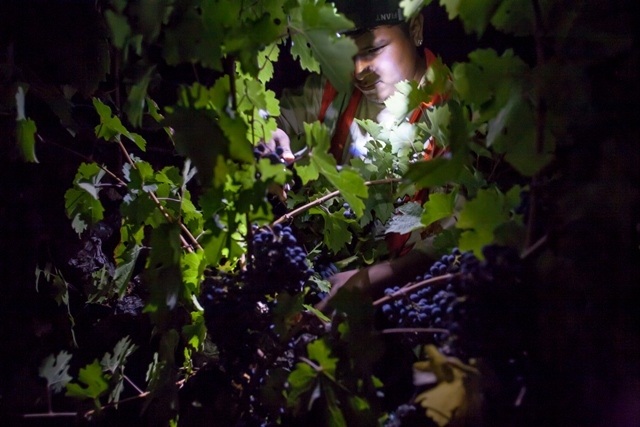
Night harvesting also provides better working conditions for the vineyard teams who work tirelessly to hand pick each cluster, ensuring only the best reach the winery. Crews will often make several passes through the same vineyard over a period of days or weeks to ensure that each cluster reaches peak ripeness before being picked.

If you’re visiting Napa Valley this time of year, be sure to keep an eye out for bright lights in the vineyards after dark; these are signs of hardworking vineyard crews harvesting the beautiful fruit of the 2018 vintage.




